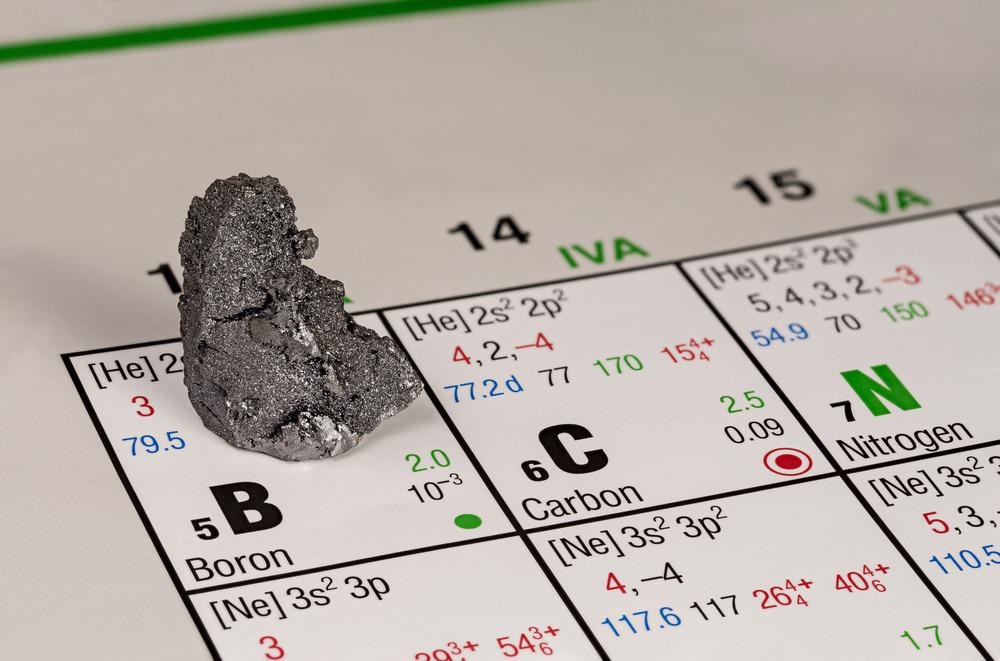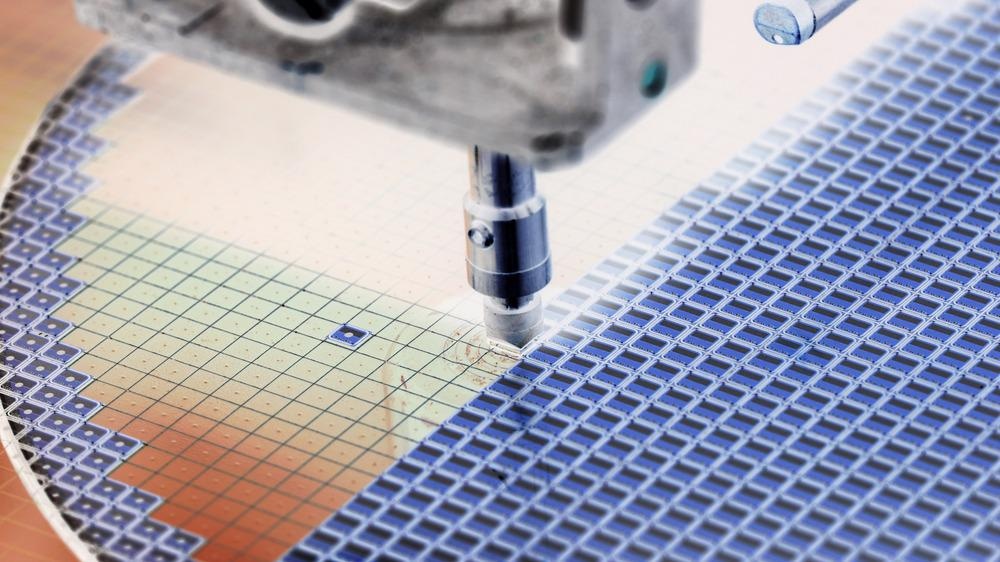Borophene, the lightest 2D metal we know of, has until recently not been widely applied in semiconductor devices. However, new research reveals that pristine hydrogenated borophene (B8H4) can be used as a semiconductor in high-performance, miniaturized electronic devices.

Image Credit: magnetix/Shutterstock.com
Opening Up the Possibility for 2D Boron-Based Semiconductors
In a paper published in the American Chemical Society’s journal Applied Nano Materials in October 2021, engineers revealed the superconducting properties of a specially synthesized type of borophene.
The team behind this study hails from the School of Information Science and Engineering, Shandong University, Qingdao, China – an institution specializing in borophene, 2D borophene nanomaterials, and novel applications for the metal including as anode materials for lithium-ion batteries.
Hydrogenated borophene (B8H4) was recently synthesized for the first time successfully, and this development opened up the possibility for 2D boron-based semiconductors.
Uncovering the Secrets of Hydrogenated Borophene
Monolayer borophene (triangular boron monolayer) was first synthesized on a substrate in 2015, as reported in Science. This opened up a new era for boron nanosheets, although challenges remained for the emerging field.
The first boron nanosheets to be synthesized were structurally unstable, and their novel physical properties were difficult to explore. In 2016, research published in Physical Chemistry Chemical Physics found that hydrogenating borophene could stabilize it.
Earlier in 2021, researchers found that using atomic hydrogen to hydrogenate 2D borophene resulted in a hydrogenated borophene with a lower local work function, that was stable for days in normal air, and was recoverable simply by thermally driving carbon off the silver substrate.
These advances mean that scientists can now work with stabilized hydrogenated borophene to explore its features and applications. The latest research on borophene in semiconductors would not be possible without stabilized hydrogenated borophene.
First-Principles Approach
The scientists behind these condensed matter theory analyses of borophene used the “first-principles” computational approach to determine its properties and applications.
The first-principles approach describes condensed matter according to the basic interactions between atoms’ constituent particles: electrons and nuclei. This turns conventional approaches to materials modeling on their head: instead of describing the material at a system level, quantum (smallest possible) components and interactions form the basis of understanding.
All interactions between atoms, such as chemical and molecular bonding, are determined by these basic interactions at the particulate level. This means that an accurate computer model of these interactions should reveal all of the complex physical phenomena that arise from them.
The physics that govern these interactions are fairly simple and well understood. There are only two-particle types—electrons and nuclei—and they behave according to the laws of basic quantum mechanics. However, first-principles modeling is still a very hard computing challenge.
Further Reading: Tackling the Chip Shortage with the Semiconductor Circular Economy
This is because of the sheer size of the problem that computers need to solve, in terms of the number of computations that feed into it. Developing accurate and efficient theoretical and computational techniques for dealing with each particle and its interactions in matter is critical to research in condensed matter theory.
Nanoscale Field-Effect Transistors
First-principles analysis in the latest study revealed that hydrogenated borophene is suitable for use in nanoscale field-effect transistors (FETs). FETs use an electric field to control the flow of current in a semiconductor device. They have three terminals: a source, gait, and drain.
FETs provide good isolation between control and flow, due to their high gate-to-drain resistance of 100 MΩ or more. They also produce less noise than bipolar junction transistors (BJT), and show no offset voltage at zero drain current. FETs are also typically more thermally stable than BJTs.

Image Credit: Macro photo/Shutterstock.com
FETs are suitable for extremely low-power switching, which means they can be miniaturized effectively due to reduced heat dissipation needs.
The new study included a detailed assessment of monolayer B8H4’s tunable electronic properties under strain engineering is important for 2D and nanoscale semiconductor manufacturing.
The team also showed how B8H4-based FETs perform in ballistic conduction. Ballistic conduction is the steady flow of energy-carrying particles over relatively long distances in a superconductor material. The boron-based FET semiconductors showed promising electrical performance for this application.
Meeting the Nanotechnology’s Cutting-Edge Requirements
The paper showed that the International Technology Roadmap for Semiconductors (ITRS) requirement for high-performance nanoscale devices could be met with pristine B8H4-based FETs.
The ITRS was produced each year by semiconductor industry figures from Europe, Japan, Korea, Taiwan, and the US between 1998 and 2015. It has since been replaced by the International Roadmap for Devices and Systems (IRDS), which was initiated under sponsorship from IEEE.
The roadmaps set the future for nanoscale electronics, showing how implants, wearables, IoT devices, and biomedical treatments will develop over the next few decades.
B8H4-based FETs are good candidates for semiconductor materials for the future of miniaturized electronics. These devices worked well with just 5 nm of channel length, performing adequately in terms of on-current, delay time, and power-delay product.
With 5% biaxial compressive strain, the researchers found that B8H4-based FETs can be scaled down even more to just 3 nm gate length.
Overall, the authors of the paper were confident that B8H4 is suitable for applications in FETs smaller than 5 nm, and that boron-based semiconductors have a promising role to play in the future of nanotechnology.
References and Further Reading
Clark, S. (2012). “What are First Principles Calculations?” Durham University. Available at: https://www.durham.ac.uk/homepage/
Daus, A. (2021). “High-performance flexible nanoscale transistors based on transition metal dichalcogenides.” Nature Electronics. Available at: https://doi.org/10.1038/s41928-021-00598-6.
Li, Q. et al. (2021). “Synthesis of borophane polymorphs through hydrogenation of borophene.” Science. Available at: https://doi.org/10.1126/science.abg1874.
Sang, P. et al. (2021). “Hydrogenated Borophene as a Promising Two-Dimensional Semiconductor for Nanoscale Field-Effect Transistors: A Computational Study.” ACS Applied Nano Materials. Available at: https://doi.org/10.1021/acsanm.1c02490.
Xu, L-C. A. Du, and L. Kou (2016). “Hydrogenated borophene as a stable two-dimensional Dirac material with an ultrahigh Fermi velocity.” Physical Chemistry Chemical Physics. Available at: https://doi.org/10.1039/C6CP05405F.
Disclaimer: The views expressed here are those of the author expressed in their private capacity and do not necessarily represent the views of AZoM.com Limited T/A AZoNetwork the owner and operator of this website. This disclaimer forms part of the Terms and conditions of use of this website.